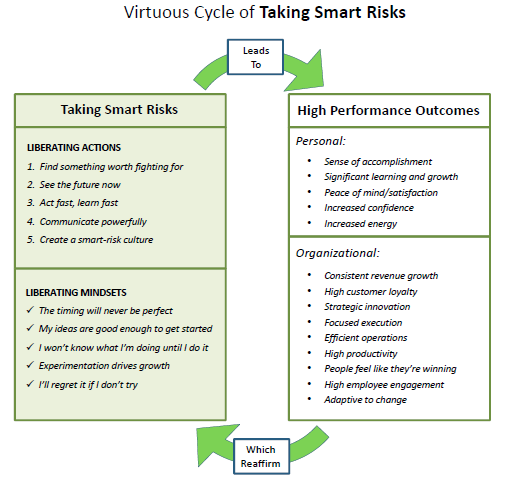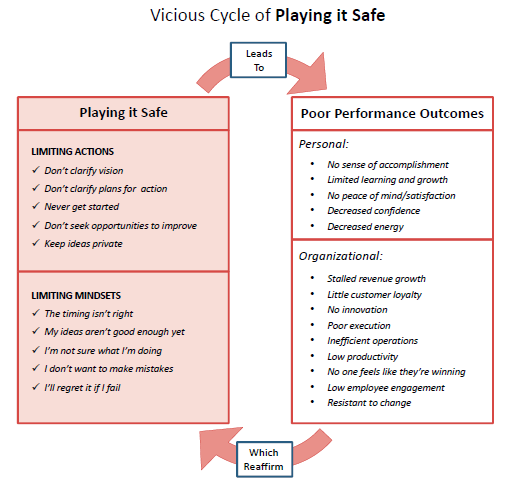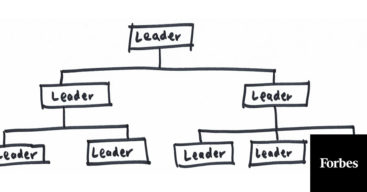Risk taking is about creating new things, understanding what you’re made of, and feeling confident and alive. You lose these when you play it safe for too long, in essence losing the “life” in life. So you need to take risks. But even when you know that you need to take risks, fear can still stop you from doing it. It’s only by being aware of what’s at stake when you do not take risks—loss of growth, progress, and learning—that you find the motivation to risk.
Smart risk taking starts by having a balanced focus on both the costs and benefits of risk taking. Too much focus on the costs leads to paralysis. Too much focus on the benefits leads to peril. Keeping both in mind puts you in the smart-risk zone. There, liberating mindsets increase your confidence to take risks. In turn, these mindsets lead to liberating actions. Over time, the mindsets and actions strengthen each other, producing high performance outcomes at both individual and organizational levels. I call this the virtuous cycle of taking smart risks (see Figure 1). With every smart risk comes more learning, more confidence, and better results.

But you can only produce positive outcomes if you continue to take risks. If you idle in “neutral” too long, you end up in a different cycle, the vicious cycle of playing it safe (see Figure 2). Here you produce increasingly poor performance outcomes until you get stuck in a rut.

I share these two risk cycles to point out that there’s no third option. There is no place where you can just stop risking and have everything remain in the status quo. Once you stop risking, you quickly stop growing. You stop producing results. You stop feeling alive.
Risk taking is a set of skills that can be learned, practiced, and sharpened
While there’s always a degree of art to taking risks—and some people are more naturally skilled at it than others—everyone can improve, finding smart ways to push outside his/her comfort zone. In my book Taking Smart Risks, I cover the process of smart risk taking with relevant stories and tools. As I researched the book, the same five themes kept popping up in everyone’s stories—from improve comedians to senior executives. Here they are with brief suggestions for action.
1. Find Something Worth Fighting For (SWFF)
- Carve time out of your schedule to stop and think about what you’re willing to fight for. You must plan for it proactively because it is nearly impossible to do this type of thinking in the course of your normal daily routine. If it’s helpful, do it with other people.
- Find a SWFF that’s challenging, something that you can and want to be good at, and something that makes a positive contribution. This ensures that the SWFF will have staying power and be truly motivating.
- If you’re clarifying a SWFF for your organization, ensure that it stirs emotion and inspires action. It should not feel like wordsmithed corporate-speak. It should feel like something that everyone cares deeply about. It’s helpful to engage a broad cross section of people for input to the SWFF.
2. See the Future Now
- Trust your instincts. The things you see and feel all around you are the most important data you can collect on the future. Never discount your own perspective. There’s a good chance that you’re the only one seeing things from your particular vantage point.
- Conversely, don’t trust only your perspective. Get out of the office and spend time with other people, especially customers. Pieces of the future are strewn everywhere, and the more you explore, the more you will find.
- Make decisions. Give yourself time, but don’t draw things out too long. Review data, talk things over with others, predict your fail points, and then decide on a course of action. Deciding builds energy on a team. Not deciding saps it.
3. Act Fast, Learn Fast
- Start before you know where to start. In the beginning of any endeavor, things are never very clear. Remember that the first hurdle is often the hardest, and that the actions needed to get out of the gate are often smaller than you realize.
- Fail fast, cheap, and small. Continually test hypotheses about what it will take to succeed. Learn from what you find, and then do more tests. Remember that the absence of failure isn’t a positive sign. It’s a sign that you’re not taking enough chances.
- Learn from everything. Remember that you’re at your weakest when you think you know all the answers. Make team learning opportunities (such as debriefings) simple and structured so that you can harvest helpful lessons quickly.
4. Communicate Powerfully
- Assume that your communication is bad. Even if it’s good, assume that it will be bad soon. This is because no matter how effective we are at communicating, we all fall victim to the communication blind spot at times—thinking that something is clear to everyone else just because it’s clear to us.
- Put regular communication structures in place to stay aligned during risk taking. Don’t rely solely on ad hoc meetings or random conversations, which tend not to happen often enough to manage risks effectively.
- Have tough conversations when they come up. Make it an expectation that those around you will do the same. Doing so decreases risk in already risky situations and increases trust.
5. Create a Smart-Risk Culture
- Define the behaviors and expectations that demonstrate a smart risk in your organization so that people are clear about whether or not they’re taking such risks—and if they’re not taking them, what they need to change.
- Measure smart risks by a broader set of results than just project success. Measure learning generated and disseminated in the organization. Measure impact on future opportunities. Acknowledge smart failures that might have missed project goals but delivered value in other ways. Doing so sends a strong message about your commitment to risk taking.
Ask yourself, “What do I have to lose?”
As you consider the areas of your business or your life where you want to take more risks, ask yourself the proverbial question, “What do I have to lose?” More often than not, if you size up the risk honestly, you’ll find that you have more to lose by not taking it than by taking it.
In all the years I’ve been helping people push themselves and their organizations further, I’ve never once heard anyone say that he regretted taking a smart risk. When done intelligently, risk taking never leaves you empty-handed. Even in failure, the experience provides critical learning for the future.
The key is to start moving. Your path forward becomes clear once you’re walking on it, not before. The risk-taking journey always brings challenges, but it also brings the strength and skill to deal with them. It always feels difficult, but it also feels meaningful and rewarding. And in the end, the journey always brings the same two realizations. You didn’t have to be a hero to succeed; you just had to keep moving. And the greatest risk in life is never risking at all.
Excerpted and adapted from Taking Smart Risks



